Rat
This articleneeds additional citations forverification.(September 2019) |
| Rats | |
|---|---|
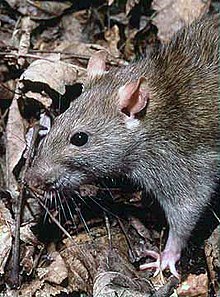
| |
| Brown rat(Rattus norvegicus) | |
| Scientific classification | |
| Domain: | Eukaryota |
| Kingdom: | Animalia |
| Phylum: | Chordata |
| Class: | Mammalia |
| Mirorder: | Simplicidentata |
| Order: | Rodentia |
Ratsare various medium-sized, long-tailedrodents.Species of rats are found throughout the order Rodentia, but stereotypical rats are found in the genusRattus.Other rat genera includeNeotoma(pack rats),Bandicota(bandicoot rats) andDipodomys(kangaroo rats).
Rats are typically distinguished frommiceby their size. Usually thecommon nameof a largemuroidrodent will include the word "rat", while a smaller muroid's name will include "mouse". The common termsratandmouseare nottaxonomicallyspecific. There are 56 known species of rats in the world.[1]
Species and description
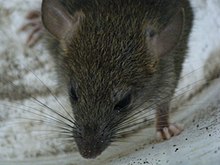

The best-known ratspeciesare theblack rat(Rattus rattus) and thebrown rat(Rattus norvegicus). This group, generally known as theOld Worldrats or true rats, originated inAsia.Rats are bigger than most Old Worldmice,which are their relatives, but seldom weigh over500 grams (17+1⁄2oz) in the wild.[2]
The termratis also used in the names of other smallmammalsthat are not true rats. Examples include the North Americanpack rats(aka wood rats[3]) and a number of species loosely calledkangaroo rats.[3]Rats such as thebandicoot rat(Bandicota bengalensis) aremurinerodents related to true rats but are not members of the genusRattus.[4][5]
Male rats are calledbucks;unmated females,does,pregnant or parent females,dams;and infants,kittensorpups.A group of rats is referred to as amischief.[6]
The common species are opportunistic survivors and often live with and nearhumans;therefore, they are known ascommensals.They may cause substantial food losses, especially in developing countries.[7]However, the widely distributed and problematic commensal species of rats are a minority in this diverse genus. Many species of rats areisland endemics,some of which have becomeendangereddue to habitat loss or competition with the brown, black, orPolynesian rat.[8]
Wild rodents, including rats, can carry many differentzoonoticpathogens, such asLeptospira,Toxoplasma gondii,andCampylobacter.[9]TheBlack Deathis traditionally believed to have been caused by the microorganismYersinia pestis,carried by the tropical rat flea (Xenopsylla cheopis), which preyed on black rats living in European cities during the epidemic outbreaks of theMiddle Ages;these rats were used as transport hosts. Another zoonotic disease linked to the rat isfoot-and-mouth disease.[10]
Rats become sexually mature at age 6 weeks, but reach social maturity at about 5 to 6 months of age. The average lifespan of rats varies by species, but many only live about a year due to predation.[11]
The black and brown rats diverged from otherOld World ratsin the forests of Asia during the beginning of thePleistocene.[12]
Rat tails
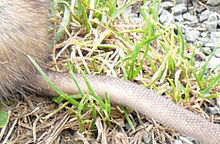
The characteristic long tail of most rodents is a feature that has been extensively studied in various rat species models, which suggest three primary functions of this structure:thermoregulation,[13]minorproprioception,and anocifensive-mediateddeglovingresponse.[14]Rodent tails—particularly in rat models—have been implicated with a thermoregulation function that follows from its anatomical construction. This particular tail morphology is evident across the family Muridae, in contrast to the bushier tails ofSciuridae,the squirrel family. The tail is hairless and thin skinned but highly vascularized, thus allowing for efficientcountercurrent heat exchangewith the environment. The highmuscularandconnective tissuedensities of the tail, along with ample muscle attachment sites along its plentifulcaudal vertebrae,facilitate specific proprioceptive senses to help orient the rodent in a three-dimensional environment.[15]Murids have evolved a unique defense mechanism termeddeglovingthat allows for escape from predation through the loss of the outermostintegumentarylayer on the tail. However, this mechanism is associated with multiplepathologiesthat have been the subject of investigation.[citation needed]
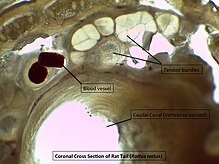
Multiple studies have explored the thermoregulatory capacity of rodent tails by subjecting test organisms to varying levels of physical activity and quantifyingheat conductionvia the animals' tails. One study demonstrated a significant disparity inheat dissipationfrom a rat's tail relative to its abdomen.[16]This observation was attributed to the higher proportion ofvascularityin the tail, as well as its highersurface-area-to-volume ratio,which directly relates to heat's ability to dissipate via the skin. These findings were confirmed in a separate study analyzing the relationships of heat storage andmechanical efficiencyin rodents that exercise in warm environments. In this study, the tail was a focal point in measuring heat accumulation and modulation.[citation needed]
On the other hand, the tail's ability to function as a proprioceptive sensor and modulator has also been investigated. As aforementioned, the tail demonstrates a high degree of muscularization and subsequentinnervationthat ostensibly collaborate in orienting the organism.[17]Specifically, this is accomplished by coordinatedflexionand extension of tail muscles to produce slight shifts in the organism'scenter of mass,orientation, etc., which ultimately assists it with achieving a state of proprioceptive balance in its environment. Further mechanobiological investigations of the constituenttendonsin the tail of the rat have identified multiple factors that influence how the organism navigates its environment with this structure. A particular example is that of a study in which the morphology of these tendons is explicated in detail.[18]Namely,cell viability testsof tendons of the rat's tail demonstrate a higher proportion of livingfibroblaststhat produce thecollagenfor these fibers. As in humans, these tendons contain a high density ofgolgi tendon organsthat help the animal assess stretching of musclein situand adjust accordingly by relaying the information to highercorticalareas associated with balance, proprioception, and movement.[citation needed]
The characteristic tail of murids also displays a unique defense mechanism known asdeglovingin which the outer layer of the integument can be detached in order to facilitate the animal's escape from a predator. This evolutionary selective pressure has persisted despite a multitude ofpathologiesthat can manifest uponsheddingpart of the tail and exposing more interior elements to the environment.[19]Paramount among these arebacterialandviralinfection, as the high density ofvascular tissuewithin the tail becomes exposed uponavulsionor similar injury to the structure. The degloving response is anocifensiveresponse, meaning that it occurs when the animal is subjected toacute pain,such as when a predator snatches the organism by the tail.[citation needed]
As pets

Specially bred rats have been kept as pets at least since the late 19th century. Pet rats are typically variants of the speciesbrown rat,butblack ratsandgiant pouched ratsare also sometimes kept. Pet rats behave differently from their wild counterparts depending on how many generations they have been kept as pets.[20]Pet rats do not pose any more of a risk ofzoonotic diseasesthan pets such ascatsordogs.[21]Tamed rats are generally friendly and can be taught to perform selected behaviors.
Selective breeding has brought about different color and marking varieties in rats. Genetic mutations have also created different fur types, such as rex and hairless. Congenital malformation in selective breeding have created the dumbo rat, a popular pet choice due to their low, saucer-shaped ears.[22]A breeding standard exists for rat fanciers wishing to breed and show their rat at a rat show.[23]
As subjects for scientific research

In 1895,Clark UniversityinWorcester, Massachusetts,established a population of domesticalbinobrown rats to study the effects of diet and for otherphysiologicalstudies.[24]Over the years, rats have been used in many experimental studies, adding to our understanding ofgenetics,diseases,the effects ofdrugs,and other topics that have provided a great benefit for thehealthand wellbeing of humankind.[25]
Theaortic archesof the rat are among the most commonly studied in murine models due to markedanatomical homologyto the humancardiovascular system.[26]Both rat and human aortic arches exhibit subsequent branching of thebrachiocephalic trunk,leftcommon carotid artery,and leftsubclavian artery,as well as geometrically similar, nonplanar curvature in theaortic branches.[26]Aortic arches studied in rats exhibit abnormalities similar to those of humans, including alteredpulmonary arteriesand double or absent aortic arches.[27]Despite existing anatomical analogy in the inthrathoracic position of the heart itself, the murine model of the heart and its structures remains a valuable tool for studies of human cardiovascular conditions.[28]
The rat's larynx has been used in experimentations that involve inhalation toxicity, allograft rejection, and irradiation responses. One experiment described four features of the rat's larynx. The first being the location and attachments of the thyroarytenoid muscle, the alar cricoarytenoid muscle, and the superior cricoarytenoid muscle, the other of the newly named muscle that ran from the arytenoid to a midline tubercle on the cricoid. The newly named muscles were not seen in the human larynx. In addition, the location and configuration of the laryngeal alar cartilage was described. The second feature was that the way the newly named muscles appear to be familiar to those in the human larynx. The third feature was that a clear understanding of how MEPs are distributed in each of the laryngeal muscles was helpful in understanding the effects of botulinum toxin injection. The MEPs in the posterior cricoarytenoid muscle, lateral cricoarytenoid muscle, cricothyroid muscle, and superior cricoarytenoid muscle were focused mostly at the midbelly. In addition, the medial thyroarytenoid muscle were focused at the midbelly while the lateral thyroarytenoid muscle MEPs were focused at the anterior third of the belly. The fourth and final feature that was cleared up was how the MEPs were distributed in the thyroarytenoid muscle.[29]
Laboratory rats have also proved valuable in psychological studies of learning and other mental processes (Barnett 2002), as well as to understandgroup behaviorand overcrowding (with the work ofJohn B. Calhounonbehavioral sink).[30][31]A 2007 study found rats to possessmetacognition,a mental ability previously only documented in humans and someprimates.[32][33]
Domestic rats differ from wild rats in many ways. They are calmer and less likely to bite; they can tolerate greater crowding; they breed earlier and produce more offspring; and theirbrains,livers,kidneys,adrenal glands,andheartsare smaller (Barnett 2002).
Brown ratsare often used asmodel organismsfor scientific research. Since the publication of the ratgenomesequence,[34]and other advances, such as the creation of a ratSNP chip,and the production ofknockout rats,thelaboratory rathas become a useful genetic tool, although not as popular asmice.When it comes to conducting tests related tointelligence,learning, anddrug abuse,rats are a popular choice due to their high intelligence, ingenuity,aggressiveness,andadaptability.Theirpsychologyseems in many ways similar to that of humans.[35]
Entirely newbreedsor "lines" of brown rats, such as theWistar rat,have been bred for use in laboratories. Much of the genome ofRattus norvegicushas been sequenced.[36]
General intelligence
Early studies found evidence both for and against measurable intelligence using the"g factor"in rats.[37][38]Part of the difficulty of understandinganimal cognition,generally, is determining what to measure.[39]One aspect of intelligence is the ability to learn, which can be measured using a maze like theT-maze.[39]Experiments done in the 1920s showed that some rats performed better than others in maze tests, and if these rats were selectively bred, their offspring also performed better, suggesting that in rats an ability to learn was heritable in some way.[39]
As food
Rat meat is a food that, whiletabooin some cultures, is a dietary staple in others.[40]
Working rats
Rats have been used as working animals. Tasks for working rats include the sniffing of gunpowder residue,demining,acting andanimal-assisted therapy.Rats have a keen sense of smell and are easy to train. These characteristics have been employed, for example, by the Belgiannon-governmental organizationAPOPO,which trains rats (specificallyAfrican giant pouched rats) to detectlandminesand diagnosetuberculosisthrough smell.[41]
As pests
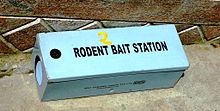
Rats have long been considered deadly pests. Once considered a modern myth, therat floodin India occurs every fifty years, as armies ofbamboo ratsdescend upon rural areas and devour everything in their path.[42]Rats have long been held up as the chief villain in the spread of theBubonic Plague;[43]however, recent studies show that rats alone could not account for the rapid spread of the disease through Europe in theMiddle Ages.[44]Still, theCenters for Disease Controldoes list nearly a dozen diseases[45]directly linked to rats.
Most urban areas battle rat infestations. A 2015 study by theAmerican Housing Survey(AHS) found that eighteen percent of homes in Philadelphia showed evidence of rodents.Boston,New York City,andWashington, D.C.,also demonstrated significant rodent infestations.[46]Indeed,rats in New York Cityare famous for their size and prevalence. The urban legend that the rat population inManhattanequals that of its human population was definitively refuted by Robert Sullivan in his bookRatsbut illustrates New Yorkers' awareness of the presence, and on occasion boldness and cleverness, of the rodents.[47]New York has specific regulations for eradicating rats; multifamily residences and commercial businesses must use a specially trained and licensedrat catcher.[48]
Chicago was declared the "rattiest city" in the US by the pest control companyOrkinin 2020, for the sixth consecutive time. It's followed byLos Angeles,New York, Washington, DC, andSan Francisco.[49]To help combat the problem, a Chicago animal shelter has placed more than 1000 feral cats (sterilized and vaccinated) outside of homes and businesses since 2012, where they hunt and catch rats while also providing a deterrent simply by their presence.[50]
Rats have the ability to swim up sewer pipes into toilets.[51][52]Rats will infest any area that provides shelter and easy access to sources of food and water, including under sinks, near garbage, and inside walls or cabinets.[53]
In the spread of disease
Rats can serve aszoonoticvectors for certain pathogens and thus spread disease, such asbubonic plague,Lassa fever,leptospirosis,andHantavirusinfection.[54]Researchers studyingNew York Citywastewater have also cited rats as the potential source of "cryptic"SARS-CoV-2lineages, due to unknown viral RNA fragments in sewage matching mutations previously shown to make SARS-CoV-2 more adept at rodent-based transmission.[55]
Rats are also associated with humandermatitisbecause they are frequently infested with blood feeding rodent mites such as the tropical rat mite (Ornithonyssus bacoti) and spiny rat mite (Laelaps echidnina), which will opportunistically bite and feed on humans,[56]where the condition is known asrat mite dermatitis.[57]
As invasive species
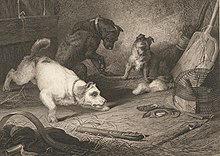
When introduced into locations where rats previously did not exist, they can wreak an enormous degree ofenvironmental degradation.Rattus rattus,theblack rat,is considered to be one of the world's worst invasive species.[58]Also known as theship rat,it has been carried worldwide as astowawayonseagoing vesselsfor millennia and has usually accompanied men to any new area visited or settled by human beings by sea. Rats first got to countries such as America and Australia by stowing away on ships.[59]The similar speciesRattus norvegicus,thebrown ratorwharf rat,has also been carried worldwide by ships in recent centuries.[60]
The ship or wharf rat has contributed to the extinction of many species of wildlife, including birds, small mammals, reptiles, invertebrates, and plants, especially on islands.True ratsareomnivorous,capable of eating a wide range of plant and animal foods, and have a very highbirth rate.When introduced to a new area, they quickly reproduce to take advantage of the new food supply. In particular, they prey on the eggs and young of forest birds, which on isolated islands often have no other predators and thus haveno fear of predators.[61]Some experts believe that rats are to blame for between forty percent and sixty percent of all seabird and reptile extinctions, with ninety percent of those occurring on islands. Thus man has indirectly caused the extinction of many species by accidentally introducing rats to new areas.[62]
Rat-free areas
Rats are found in nearly all areas of Earth which are inhabited by human beings. The only rat-free continent isAntarctica,which is too cold for rat survival outdoors, and its lack of human habitation does not provide buildings to shelter them from the weather. However, rats have been introduced to many of the islands near Antarctica, and because of their destructive effect on native flora and fauna, efforts to eradicate them are ongoing. In particular,Bird Island(just off rat-infestedSouth Georgia Island), where breeding seabirds could be badly affected if rats were introduced, is subject to special measures and regularly monitored for rat invasions.[63]
As part ofisland restoration,some islands' rat populations have been eradicated to protect or restore theecology.Hawadax Island, Alaskawas declared rat free after 229 years[64]andCampbell Island, New Zealandafter almost 200 years.[65][66]Breaksea Islandin New Zealand was declared rat free in 1988 after an eradication campaign based on a successful trial on the smaller Hawea Island nearby.[67][68]
In January 2015, an international "Rat Team" set sail from theFalkland Islandsfor theBritish Overseas TerritoryofSouth Georgia and the South Sandwich Islandson board a ship carrying three helicopters and 100 tons of rat poison with the objective of "reclaiming the island for its seabirds". Rats have wiped out more than 90% of the seabirds on South Georgia, and the sponsors hope that once the rats are gone, it will regain its former status as home to the greatest concentration of seabirds in the world. The South Georgia Heritage Trust, which organized the mission describes it as "five times larger than any other rodent eradication attempted worldwide".[69]That would be true if it were not for the rat control program in Alberta (see below).
The Canadian province ofAlbertais notable for being the largest inhabited area on Earth which is free of true rats due to very aggressive government rat control policies. It has large numbers of nativepack rats,also called bushy-tailed wood rats, but they are forest-dwelling vegetarians which are much less destructive than true rats.[70]
Alberta was settled by Europeans relatively late in North American history and only became a province in 1905. Black rats cannot survive in its climate at all, and brown rats must live near people and in their structures to survive the winters. There are numerous predators in Canada's vast natural areas which will eat non-native rats, so it took until 1950 for invading rats to make their way over land from Eastern Canada.[71]Immediately upon their arrival at the eastern border withSaskatchewan,the Alberta government implemented an extremely aggressive rat control program to stop them from advancing further. A systematic detection and eradication system was used throughout a control zone about 600 kilometres (400 mi) long and 30 kilometres (20 mi) wide along the eastern border to eliminate rat infestations before the rats could spread further into the province. Shotguns, bulldozers, high explosives, poison gas, and incendiaries were used to destroy rats. Numerous farm buildings were destroyed in the process. Initially, tons ofarsenic trioxidewere spread around thousands of farm yards to poison rats, but soon after the program commenced therodenticideand medical drugwarfarinwas introduced, which is much safer for people and more effective at killing rats than arsenic.[72]
Forceful government control measures, strong public support and enthusiastic citizen participation continue to keep rat infestations to a minimum.[73]The effectiveness has been aided by a similar but newer program in Saskatchewan which prevents rats from even reaching the Alberta border. Alberta still employs an armed rat patrol to control rats along Alberta's borders. About ten single rats are found and killed per year, and occasionally a large localized infestation has to be dug out with heavy machinery, but the number of permanent rat infestations is zero.[74]
In culture
Ancient Romansdid not generally differentiate between rats and mice, instead referring to the former asmus maximus(big mouse) and the latter asmus minimus(little mouse).[75]
On theIsle of Man,there is atabooagainst the word "rat".[76]
Asian cultures
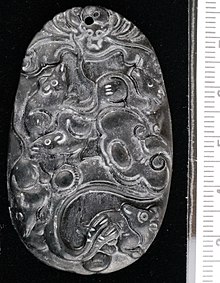
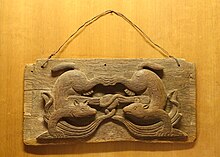
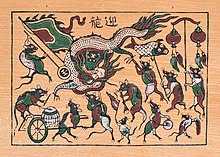
The rat (sometimes referred to as a mouse) is the first of the twelve animals of theChinese zodiac.People born in this year are expected to possess qualities associated with rats, including creativity, intelligence, honesty, generosity, ambition, a quick temper and wastefulness. People born in a year of the rat are said to get along well with "monkeys" and "dragons", and to get along poorly with "horses".
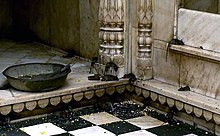
In Indian tradition, rats are seen as the vehicle ofGanesha,and a rat's statue is always found in a temple of Ganesh. In the northwestern Indian city ofDeshnoke,the rats at theKarni Mata Templeare held to be destined forreincarnationasSadhus(Hinduholy men). The attending priests feed milk and grain to the rats, of which the pilgrims also partake.
European cultures
European associations with the rat are generally negative. For instance, "Rats!" is used as a substitute for various vulgarinterjectionsin the English language. These associations do not draw,per se,from any biological or behavioral trait of the rat, but possibly from the association of rats (andfleas) with the 14th-century medieval plague called theBlack Death.Rats are seen as vicious, unclean, parasitic animals that steal food and spread disease. In 1522, the rats inAutun,Francewere charged and put ontrialfor destroying crops.[77]However, some people in European cultures keeprats as petsand conversely find them to be tame, clean, intelligent, and playful.
Rats are often used in scientificexperiments;animal rightsactivists allege the treatment of rats in this context is cruel. The term "lab rat" is used, typically in a self-effacing manner, to describe a person whose job function requires them to spend a majority of their work time engaged in bench-level research (such aspostgraduate studentsin the sciences).
Terminology
Rats are frequently blamed for damaging food supplies and other goods, or spreading disease. Their reputation has carried into common parlance: in theEnglish language,"rat" is often an insult or is generally used to signify an unscrupulous character; it is also used, as a synonym for the termnark,to mean an individual who works as a policeinformantor who has turnedstate's evidence.Writer/directorPreston Sturgescreated the humorous alias "Ratskywatsky" for a soldier who seduced, impregnated, and abandoned the heroine of his 1944 film,The Miracle of Morgan's Creek.It is a term (nounandverb) in criminal slang for aninformant– "to rat on someone" is to betray them by informing the authorities of acrimeor misdeed they committed. Describing a person as "rat-like" usually implies he or she is unattractive and suspicious.
Amongtrade unions,the word "rat" is also a term for nonunion employers or breakers of union contracts, and this is why unions useinflatable rats.[78]
Fiction

Depictions of rats in fiction are historically inaccurate and negative. The most common falsehood is the squeaking almost always heard in otherwise realistic portrayals (i.e. nonanthropomorphic). While the recordings may be of actual squeaking rats, the noise is uncommon – they may do so only if distressed, hurt, or annoyed. Normal vocalizations are very high-pitched, well outside the range of human hearing. Rats are also often cast in vicious and aggressive roles when in fact, their shyness helps keep them undiscovered for so long in an infested home.
The actual portrayals of rats vary from negative to positive with a majority in the negative and ambiguous.[79]The rat plays a villain in several mouse societies; from Brian Jacques'sRedwalland Robin Jarvis'sThe Deptford Mice,to the roles of Disney'sProfessor Ratiganand Kate DiCamillo'sRoscuroandBotticelli.They have often been used as a mechanism in horror; being the titular evil in stories likeThe Ratsor H.P. Lovecraft'sThe Rats in the Walls[79]and in films likeWillardandBen.Another terrifying use of rats is as a method oftorture,for instance inRoom 101in George Orwell'sNineteen Eighty-FourorThe Pit and the PendulumbyEdgar Allan Poe.
Selfish helpfulness —those willing to help for a price— has also been attributed to fictional rats.[79]Templeton, from E. B. White'sCharlotte's Web,repeatedly reminds the other characters that he is only involved because it means more food for him, and the cellar-rat of John Masefield'sThe Midnight Folkrequires bribery to be of any assistance.
By contrast, the rats appearing in theDoctor Dolittlebooks tend to be highly positive and likeable characters, many of whom tell their remarkable life stories in the Mouse and Rat Club established by the animal-loving doctor.
Some fictional works use rats as the main characters. Notable examples include the society created by O'Brien'sMrs. Frisby and the Rats of NIMH,and others includeDoctor Rat,andRizzo the RatfromThe Muppets.Pixar's 2007 animated filmRatatouilleis about a rat described byRoger Ebertas "earnest... lovable, determined, [and] gifted" who lives with a Parisian garbage-boy-turned-chef.[80]
Mon oncle d'Amérique( "My American Uncle"), a 1980French film,illustratesHenri Laborit's theories onevolutionary psychologyandhuman behaviorsby using short sequences in the storyline showing lab rat experiments.
InHarry Turtledove's science fiction novelHomeward Bound,humans unintentionally introduce rats to the ecology at the home world of an alien race which previously invaded Earth and introduced some of its own fauna into its environment.A. Bertram Chandlerpitted the space-bound protagonist of a long series of novels, Commodore Grimes, against giant, intelligent rats who took over several stellar systems and enslaved their human inhabitants. "The Stainless Steel Rat"is nickname of the (human) protagonist of a series of humorousscience fictionnovelswritten byHarry Harrison.
Wererats,therianthropiccreatures able to take the shape of a rat,[81]have appeared in the fantasy or horror genre since the 1970s. The term is a neologism coined in analogy towerewolf.[citation needed]The concept has since become common inrole playing gameslikeDungeons & Dragons[81][82][83]and fantasy fiction like theAnita Blakeseries.[84]
The Pied Piper
One of the oldest and most historic stories about rats is "The Pied Piper of Hamelin",in which arat-catcherleads away an infestation with enchanted music.[85]The piper is later refused payment, so he in turn leads away the town's children. This tale, traced toGermanyaround the late 13th century, has inspired adaptations in film, theatre, literature, and even opera. The subject of much research, some theories have intertwined the tale with events related to theBlack Plague,in whichblack ratsplayed an important role. Fictional works based on the tale that focus heavily on the rat aspect include Pratchett'sThe Amazing Maurice and his Educated Rodents,and Belgian graphic novelLe Bal du Rat Mort(The Ball of the Dead Rat). Furthermore, a linguistic phenomenon when a wh-expression drags with it an entire encompassing phrase to the front of the clause has been namedpied-pipingafter "Pied Piper of Hamlin" (see alsopied-piping with inversion).
See also
References
- ^"Rat Fact Sheet".Nature.Retrieved2021-09-23.
- ^"Habits, Habitat & Types of Mice".Live Science.26 June 2014.Archivedfrom the original on 24 May 2015.Retrieved23 May2015.
- ^abBritannica Concise Encyclopedia.Chicago, IL: Britannica Digital Learning. 2017 – via Credo Reference.
- ^"Bandicota Gray, 1873".gbif.org.Retrieved2024-03-10.
- ^"ITIS - Report: Bandicota bengalensis".itis.gov.Retrieved2024-03-10.
- ^"Creature Feature Rats".ABC.net.au.Archived fromthe originalon 24 May 2015.Retrieved23 May2015.
- ^Meerburg BG, Singleton GR, Leirs H (2009)."The Year of the Rat ends: time to fight hunger!".Pest Manag Sci.65(4): 351–2.doi:10.1002/ps.1718.PMID19206089.Archived fromthe originalon 2012-12-17.
- ^Stokes, Vicki L.; Banks, Peter B.; Pech, Roger P.; Spratt, David M. (2009)."Competition in an invaded rodent community reveals black rats as a threat to native bush rats in littoral rainforest of south-eastern Australia".Journal of Applied Ecology.46(6): 1239–1247.Bibcode:2009JApEc..46.1239S.doi:10.1111/j.1365-2664.2009.01735.x.
- ^Meerburg BG, Singleton GR, Kijlstra A (2009). "Rodent-borne diseases and their risks for public health".Crit Rev Microbiol.35(3): 221–70.doi:10.1080/10408410902989837.PMID19548807.S2CID205694138.
- ^Capel-Edwards, Maureen (October 1970). "Foot-and-mouth disease in the brown rat".Journal of Comparative Pathology.80(4): 543–548.doi:10.1016/0021-9975(70)90051-4.PMID4321688.
- ^"How old is a rat in human years?".RatBehavior.org.Archivedfrom the original on 12 June 2015.Retrieved23 May2015.
- ^Aplin, Ken P.; Suzuki, Hitoshi; Chinen, Alejandro A.; Chesser, R. Terry; ten Have, José; Donnellan, Stephen C.; et al. (November 2011)."Multiple Geographic Origins of Commensalism and Complex Dispersal History of Black Rats".PLOS ONE.6(11): e26357.Bibcode:2011PLoSO...626357A.doi:10.1371/journal.pone.0026357.PMC3206810.PMID22073158.
- ^"Rat Tails".Rat Behavior and Biology.Retrieved30 July2020.
- ^Grant, Karen."Degloving Injury".Rat Health Guide.Retrieved30 July2020.
- ^Vincent JA, Gabriel HM, Deardorff AS, Nardelli P, Fyffe RE, Burkholder T, Cope TC (1 November 2017)."Muscle proprioceptors in adult rat: mechanosensory signaling and synapse distribution in spinal cord".Journal of Neurophysiology.118(5): 2687–2701.doi:10.1152/jn.00497.2017.ISSN0022-3077.PMC5672542.PMID28814636.
- ^Wanner, Samuel (2015)."Thermoregulatory responses in exercising rats: methodological aspects and relevance to human physiology".Temperature.2(4): 457–75.doi:10.1080/23328940.2015.1119615.PMC4844073.PMID27227066.
- ^Mackenzie, SJ (2015). "Innervation and function of rat tail muscles for modeling cauda equina injury and repair".Muscle and Nerve.52(1): 94–102.doi:10.1002/mus.24498.PMID25346299.S2CID40356618.
- ^Bruneau, Amelia (2010)."Preparation of Rat Tail Tendons for Biomechanical and Mechanobiological Studies".Journal of Visualized Experiments.41(41): 2176.doi:10.3791/2176.PMC3156064.PMID20729800.
- ^Milcheski, Dimas (2012). "Development of an experimental model of degloving injury in rats".Brazilian Journal of Plastic Surgery.27:514–17.
- ^"Wild Rats in Captivity and Domestic Rats in the Wild".Ratbehaviour.org.Archivedfrom the original on 2009-04-13.Retrieved2009-07-04.
- ^"Merk Veterinary Manual Global Zoonoses Table".Merckvetmanual. Archived fromthe originalon 2007-02-17.Retrieved2006-11-24.
- ^Katerji, Suhair (1 May 2009)."Expression of Msx1 and Dlx1 during Dumbo rat head development: correlation with morphological features".Genetics and Molecular Biology.32(2): 399–404.doi:10.1590/S1415-47572009005000041.PMC3036941.PMID21637698.
- ^"AFRMA OFFICIAL RAT STANDARD".American Fancy Rat & Mouse Association.Retrieved13 October2020.
- ^"Rat - an overview | ScienceDirect Topics".sciencedirect.Retrieved2024-04-09.
- ^Research, National Research Council (US) and Institute of Medicine (US) Committee on the Use of Laboratory Animals in Biomedical and Behavioral (1988),"Benefits Derived from the Use of Animals",Use of Laboratory Animals in Biomedical and Behavioral Research,National Academies Press (US),retrieved2024-04-09
- ^abCasteleyn, Christophe; Trachet, Bram; Van Loo, Denis; Devos, Daniel G H; Van den Broeck, Wim; Simoens, Paul; Cornillie, Pieter (2017-04-19)."Validation of the murine aortic arch as a model to study human vascular diseases".Journal of Anatomy.216(5): 563–571.doi:10.1111/j.1469-7580.2010.01220.x.ISSN0021-8782.PMC2871992.PMID20345858.
- ^Wilson, James G.; Warkany, Josef (1950-04-01)."Cardiac and Aortic Arch Anomalies in the Offspring of Vitamin a Deficient Rats Correlated with Similar Human Anomalies".Pediatrics.5(4): 708–725.doi:10.1542/peds.5.4.708.ISSN0031-4005.PMID15417271.S2CID46479766.Archivedfrom the original on 2017-08-18.
- ^Casteleyn, Christophe; Trachet, Bram; Van Loo, Denis; Devos, Daniel G H; Van den Broeck, Wim; Simoens, Paul; Cornillie, Pieter (2017-04-27)."Validation of the murine aortic arch as a model to study human vascular diseases".Journal of Anatomy.216(5): 563–571.doi:10.1111/j.1469-7580.2010.01220.x.ISSN0021-8782.PMC2871992.PMID20345858.
- ^Inagi, Katsuhide; Schultz, Edward; Ford, Charles (1998). "An Anatomic Study of the Rat Larynx: Establishing the Rat Model for Neuromuscular Function".Otolaryngology–Head and Neck Surgery.118(1): 74–81.doi:10.1016/s0194-5998(98)70378-x.PMID9450832.S2CID30325002.
- ^"Why do we use rats?".Cambridge University.28 October 2016.RetrievedApril 9,2024.
- ^Ramsden, Edmund; Adams, Jon (January 2008)."Escaping the Laboratory: The Rodent Experiments of John B. Calhoun & Their Cultural Influence"(PDF).Department of Economic History at London School of Economics.RetrievedApril 9,2024.
- ^Foote, Allison L.; Jonathon D. Crystal (20 March 2007)."Metacognition in the rat".Current Biology.17(6): 551–555.Bibcode:2007CBio...17..551F.doi:10.1016/j.cub.2007.01.061.PMC1861845.PMID17346969.Archived fromthe originalon 3 July 2012.
- ^"Rats Capable Of Reflecting On Mental Processes".Sciencedaily. 2007-03-09.Archivedfrom the original on 2012-10-10.Retrieved2012-09-24.
- ^Gibbs RA et al.: Genome sequence of the Brown Norway rat yields insights into mammalian evolution.: Nature. 2004 April 1; 428(6982):475–6.
- ^"Animal studies in psychology".American Psychological Association.January 2017.RetrievedApril 9,2024.
- ^"Genome project".ensembl.org.Archivedfrom the original on 26 April 2006.Retrieved17 February2007.
- ^Lashley, K.,Brain Mechanisms and Intelligence,Dover Publications, New York, 1929/1963, 186 pp.
- ^Thorndike, R (1935). "Organization of behavior in the albino rat".Genet. Psychol. Monogr.17:1–70.
- ^abcMatzel, LD; Sauce, B (October 2017)."Individual differences: Case studies of rodent and primate intelligence".Journal of Experimental Psychology: Animal Learning and Cognition.43(4): 325–340.doi:10.1037/xan0000152.PMC5646700.PMID28981308.
- ^Newvision Archive (2005-03-10)."Rats for dinner, a delicacy to some, a taboo to many".Newvision.co.ug. Archived fromthe originalon 2012-09-22.Retrieved2012-09-24.
- ^"Video of Bart Weetjens talk on use of rats as odour detectors".Ted.Archivedfrom the original on 2012-10-07.Retrieved2012-09-24.
- ^"Massive plagues of rats swarm across India every fifty years".Io9. 19 November 2010.Archivedfrom the original on 2013-05-21.Retrieved2013-03-15.
- ^"The Black Plague".University of North Carolina.Archivedfrom the original on 2013-03-01.Retrieved2013-03-15.
- ^Maev Kennedy (2011-08-17)."Black Death study lets rats off the hook".The Guardian.London.Archivedfrom the original on 2013-08-27.Retrieved2013-03-15.
- ^"CDC – Diseases directly transmitted by rodents – Rodents".Centers for Disease Control. 2011-06-07.Archivedfrom the original on 2013-03-17.Retrieved2013-03-15.
- ^Clark, Patrick (2017-01-17)."The Most Vermin-Infested American Cities".Bloomberg.Archivedfrom the original on 2017-01-18.Retrieved2017-01-18.
- ^Wilsey, Sean (2005-03-17)."Sean Wilsey reviews 'Rats' by Robert Sullivan · LRB 17 March 2005".London Review of Books.Lrb.co.uk. pp. 9–10.Archivedfrom the original on 9 February 2013.Retrieved2013-03-15.
- ^"Questions and Answers Regarding New York State Pest Management Program".DOEC of NY State.Archivedfrom the original on 2014-12-17.Retrieved2014-11-24.
- ^"Rats! Chicago Tops Orkin's Rattiest Cities List for Sixth Consecutive Time".PR Newswire.13 Oct 2020.Retrieved16 May2021.
- ^Guzman, Joseph (11 May 2021)."1,000 feral cats released onto Chicago streets to tackle rat explosion".The Hill.Retrieved16 May2021.
- ^Klein, Stephanie (2014-10-17)."How to keep the rats from coming up through your toilet".Archivedfrom the original on 2015-09-01.Retrieved2015-08-23.
- ^"See How Easily a Rat Can Wriggle Up Your Toilet".video.nationalgeographic.Archived fromthe originalon 2015-08-21.Retrieved2015-08-23.
- ^"Identify and Prevent Rodent Infestations".epa.gov.United States Environmental Protection Agency. 2013-10-31.Retrieved2019-12-05.
- ^"Information on other rodent-related diseases – Leptospirosis Information".Leptospirosis Information.Archivedfrom the original on 2016-10-31.Retrieved2016-10-31.
- ^Mench, Chris (4 February 2022)."New York City's Rats Could Have Their Own Strain of COVID-19".Thrillist. Archived fromthe originalon 5 February 2022.Retrieved8 February2022.
- ^Watson, J. (2008). New building, old parasite: Mesostigmatid mites—an ever-present threat to barrier rodent facilities.ILAR journal,49(3), 303–309.
- ^Engel, Peter M.; Welzel, J.; Maass, M.; Schramm, U.; Wolff, H. H. (1998)."Tropical Rat Mite Dermatitis: Case Report and Review".Clinical Infectious Diseases.27(6): 1465–1469.doi:10.1086/515016.ISSN1058-4838.PMID9868661.
- ^"100 of the World's Worst Invasive Alien Species".Global Invasive Species Database.Archivedfrom the original on 27 February 2013.Retrieved17 February2013.
- ^"Predation by exotic rats on Australian offshore islands of less than 1000 km2 (100,000 ha) listing advice"(PDF).Government of Australia.Retrieved16 February2023.
- ^"Species – Brown Rat".The Mammal Society.Retrieved2024-03-10.
- ^"Rattus rattus (mammal)".Global Invasive Species Database. Archived fromthe originalon 20 October 2015.Retrieved17 January2015.
- ^"Humans outdone by Rats for causing Extinctions".Science Avenger. 2007-12-05.Archivedfrom the original on 19 January 2015.Retrieved17 January2015.
- ^"Preventing the introduction of non-native species to Antarctica".British Antarctic Survey. Archived fromthe originalon 8 January 2015.Retrieved17 January2015.
- ^Rosen, Yereth (2009-06-13)."Hawadax Island Is Rat-Free".Reuters.Retrieved2024-03-10.
- ^Cooper, John (2022-12-13)."Pioneering rodent eradication in the sub-Antarctic: the Campbell Island Rat Eradication Project".Mouse-Free Marion.Retrieved2024-03-10.
- ^"Eradication—The Clearance of Campbell Island".New Zealand Geographic.Retrieved2024-03-10.
- ^Taylor, R.H.; Thomas, B.W. (1989)."Eradication of Norway Rats (rattus Norvegicus) from Hawea Island, Fiordland, Using Brodifacoum".New Zealand Journal of Ecology.12:23–32.ISSN0110-6465.JSTOR24053177.
- ^Guthrie, Kate (2020-03-22)."Rat eradication breakthrough — Breaksea Island 1988".Predator Free NZ Trust.Retrieved2024-03-10.
- ^Gill, First= Victoria (23 January 2015)."South Georgia rat eradication mission sets sail".BBC.Archivedfrom the original on 24 January 2015.Retrieved21 January2015.
- ^"Bushy-Tailed Woodrat (Pack Rat)".Pest Control Canada.Archivedfrom the original on 29 June 2017.Retrieved8 August2017.
- ^"Rattus norvegicus (mammal) – Details of this species in Alberta".Global Invasive Species Database. Archived fromthe originalon 26 October 2014.Retrieved18 October2014.
- ^"The History of Rat Control In Alberta".Alberta Department of Agriculture and Rural Development. Archived fromthe originalon 25 September 2014.Retrieved18 October2014.
- ^"Rat Control in Alberta".Alberta Department of Agriculture and Rural Development. Archived fromthe originalon 26 September 2014.Retrieved18 October2014.
- ^Giovannetti, Justin (26 November 2015)."On the frontlines of Alberta's war against rats".Toronto Globe and Mail.Archivedfrom the original on 22 January 2017.Retrieved8 August2017.
- ^"NATURE NOTES: Mus Maximus".wigantoday.net.Archived fromthe originalon 2019-02-02.Retrieved2019-02-01.
- ^Eyers, Jonathan (2011).Don't Shoot the Albatross!: Nautical Myths and Superstitions.A&C Black, London, UK.ISBN978-1-4081-3131-2.
- ^MacKinnon, J. B. (September 26, 2023)."In Defense of the Rat".hakaimagazine.Hakai Magazine. Archived fromthe originalon October 3, 2023.RetrievedOctober 8,2023.
- ^"Nevada Journal: Louts and the Rat World".Nj.npri.org. Archived fromthe originalon 2013-05-20.Retrieved2012-09-24.
- ^abcClute, John; John Grant (March 15, 1999).The Encyclopedia of Fantasy.St. Martin's Griffin. p. 642.ISBN978-0-312-19869-5.
- ^Ebert, Roger (2008).Roger Ebert's Four-Star Reviews 1967–2007.Andrews McMeel Publishing. p. 637.ISBN978-0-7407-7179-8.
Remy, the earnest little rat who is its hero, is such a lovable, determined, gifted rodent that I want to know what happens to him next, now that he has conquered the summit of French cuisine.
- ^abDavid "Zeb" Cook;Steve Winter;Jon Pickens;et al. (1989).Monstrous Compendium Volume One.TSR, Inc.ISBN0-8803-8738-6.
- ^Gygax, Garyand Robert Kuntz.Supplement I: Greyhawk(TSR, 1975).
Gygax, Gary.Monster Manual(TSR, 1977).
Allston, Aaron,Steven E. Schend,Jon Pickens,and Dori Watry.Dungeons & Dragons Rules Cyclopedia(TSR, 1991).
Dupuis, Ann.Night Howlers(TSR,1992).
Swan, Rick(April 1993). "Role-playing Reviews".Dragon(#192).Lake Geneva, Wisconsin:TSR:86.
Stewart, Doug,ed.Monstrous Manual(TSR, 1993).
Johnson, Kristin (September 1998). "Ecology of the Wererat".Dragon(251). TSR.
Williams, Skip,Jonathan Tweet,andMonte Cook.Monster Manual.Wizards of the Coast,2000.
Poisso, Dean. "Animal Ancestry."Dragon#313 (Paizo Publishing,2003). - ^Bryan Armor; Christine Gregory; Ellen Kiley; et al. (2000).Dragons of the East.White Wolf Publishing, Inc.p. 92.ISBN1-56504-428-2.
- ^Fusco, Virginia (2015).Monstrous Figurations: Notes for a Feminist Reading(Tesis doctoral). Universidad Carlos III de Madrid. pp. 4, 122.
- ^Kadushin, Raphael (3 September 2020)."The grim truth behind the Pied Piper".BBC Travel.
Further reading
- List of books and articles about rats,is anon-fictionlist.
- Smith, Robert (Rat-catcher) (1786)The universal directory for taking alive and destroying rats
External links
- High-Resolution Images of the Rat Brain(archived 3 March 2016)
- National Bio Resource Project for the Rat in Japan(archived 29 April 2005)
- Rat Behaviour and Biology
- Rat Genome Database
 Texts on Wikisource:
Texts on Wikisource:
- "Rat".New International Encyclopedia.1905.
- "Rat".Encyclopædia Britannica(11th ed.). 1911.
- "Rat".Encyclopedia Americana.1920.
